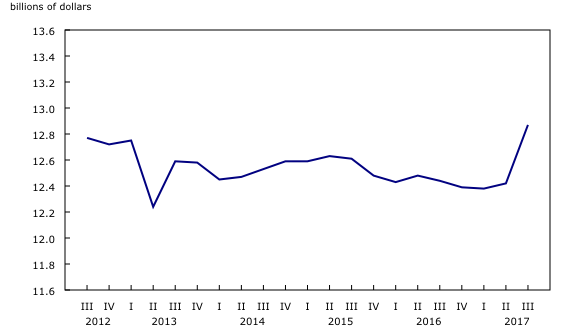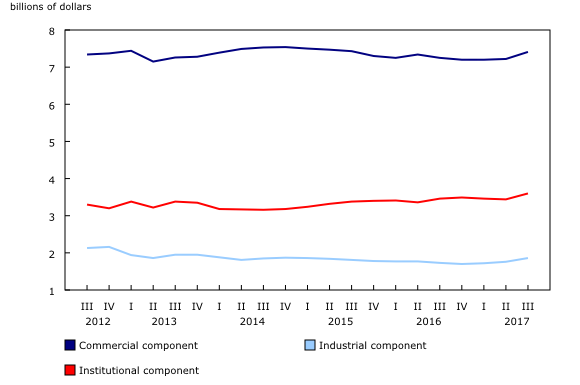Investment in non-residential building construction, third quarter 2017
Archived Content
Information identified as archived is provided for reference, research or recordkeeping purposes. It is not subject to the Government of Canada Web Standards and has not been altered or updated since it was archived. Please "contact us" to request a format other than those available.
Released: 2017-10-16
$12.9 billion
Third quarter 2017
3.6% 
(quarterly change)
Investment in non-residential building construction totalled $12.9 billion in the third quarter, up 3.6% from the previous quarter. At the national level, spending increased in all three components (institutional, industrial, and commercial), led by commercial (+$186.5 million) and institutional buildings (+$158.2 million).
Investment in educational buildings leads increase in the institutional component
Investment in the institutional component rose by 4.6% to $3.6 billion in the third quarter, following two consecutive quarterly declines. The largest gains were reported in Ontario and Quebec, led by spending on educational buildings.
Investment in educational buildings, which includes schools, colleges and universities, rose by 18% (+$285.6 million) in the third quarter to $1.9 billion. This was the third-highest investment in educational buildings since 1997, the year Statistics Canada began publishing data on investment in construction of non-residential buildings.
Spending on educational buildings accounted for approximately 15% of total investment in non-residential buildings in the third quarter, surpassing total investment in industrial buildings for the first time since the third quarter of 2011.
Spending on educational buildings increased in seven provinces, led by Ontario (+$145 million) and Quebec (+$91 million).
The Post-secondary Institutions Strategic Investment Fund, a measure announced in the 2016 Federal Budget, which tabled plans to invest up to $2 billion in post-secondary institution infrastructure by April 30, 2018, may have contributed to the increase.
Office building leads the commercial component
Spending on commercial buildings rose 2.6% to $7.4 billion in the third quarter, with Ontario (+$127.8 million) posting the largest gain, followed by Quebec (+$112.1 million). The increase in both provinces was mainly attributable to higher investment in office building construction.
Industrial component increases, led by farm building
Investment in industrial projects increased 6.0% to $1.9 billion in the third quarter—the largest month-over-month increase since the third quarter of 2012. At the national level, the gain was the result of higher investment in the construction of farm buildings and, to a lesser extent, manufacturing plants.
Note to readers
Unless otherwise stated, this release presents seasonally adjusted data expressed in current dollars, which facilitate comparisons by removing the effects of seasonal variations. For more information on seasonal adjustment, see Seasonally adjusted data – Frequently asked questions.
Investments in non-residential building construction exclude engineering construction (such as for highways, sewers, bridges, and oil and gas pipelines). These data are from the Building Permits Survey of municipalities, which collects information on construction intentions.
Work put-in-place patterns are assigned to each type of structure (industrial, commercial and institutional). These work patterns are used to distribute the value of building permits according to project length. Work put-in-place patterns differ according to the value of the construction project; a project worth several million dollars will usually take longer to complete than will a project worth a few hundred thousand dollars.
Additional data from the Capital and Repair Expenditures Survey are used to create this investment series. Investments in non-residential building data are also benchmarked to Statistics Canada's System of National Accounts' non-residential building investment series.
For the purpose of this release, the census metropolitan area of Ottawa–Gatineau (Ontario/Quebec) is divided into two areas: the Ottawa part and the Gatineau part.
Unless otherwise specified, the highlights refer to current dollars and are ranked in terms of dollar change rather than percentage change.
Contact information
For more information, or to enquire about the concepts, methods or daily quality of this release, contact us (toll-free 1-800-263-1136; 514-283-8300; STATCAN.infostats-infostats.STATCAN@canada.ca) or Media Relations (613-951-4636; STATCAN.mediahotline-ligneinfomedias.STATCAN@canada.ca).
- Date modified:



